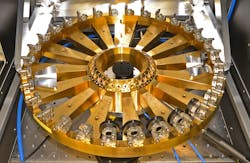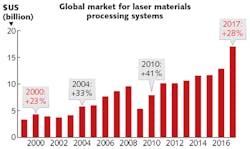Laser sources have been developed to a high level of maturity and hence, new concepts are rare. But one new concept was presented by Thomas Graf at the recent Stuttgart Laser Technology Forum (SLT2018). He is the director of the Institut für Strahlwerkzeuge (IFSW) of the University of Stuttgart, which is organizing this conference every two years in co-location with LASYS (June 5-7), the international trade show for industrial laser technology in Stuttgart, Germany.
Graf analyzed the structure of modern ultrashort-pulsed (USP; a.k.a. ultrafast) laser systems in the kilowatt class and came to a surprising conclusion: It would be fairly easy to replace the pulsed seed laser with a continuous-wave (CW) laser and let the system make kilowatt CW radiation. With little or no extra cost, this system could produce CW, pulsed, or USP radiation.
This is quite an interesting idea. While other systems such as diode lasers deserve an extra tutorial to understand their many options, USP lasers could become simpler. Although the idea was presented for disk laser amplifiers (see Fig. 1), one might think about other geometries as well. The concept did not show obvious limitations for other options like frequency conversion. So, Graf envisions the future of this laser system as one box to serve many different applications.
The other presentations at the two-day convention mainly dealt with upscaling USP and CW lasers toward the kilowatt region and what this means for the process technology. Graf also mentioned a topical issue on Ultrafast Laser Matter Interaction in Advanced Optical Technologies that he and his Swiss colleague Beat Neuenschwander edited recently. Several authors discussed the conditions for proper application of kilowatt USP radiation in this issue. The problem there is a rising thermal load: The so-called cold ablation isn’t cold anymore at high powers, but with some rules and considerations, the problem can be managed.
LASYS and its siblings
The SLT Congress was held at the Congress Center of Messe Stuttgart, near the LASYS International Trade Fair for Laser Material Processing. With 189 exhibitors from over 20 countries, LASYS has grown a bit from the 181 exhibitors in 2016. The organizers added several parallel events to add critical mass and to offer more value for the visitors.
In one hall was the Autonomous Vehicle Technology World Expo 2018, which itself came as part of a group of automotive events (Engine Expo, Automotive Interiors Expo, Automotive Testing Expo, and the Global Automotive Components and Suppliers Expo). While the autonomous vehicle expo listed 85 exhibitors, the organizer claimed to have 800 companies from the automotive sector in all these events.
Another first was CastForge, a new trade show for the casting and forging sector with more than 150 exhibitors. Last but not least, the rebranded SurfaceTechnology Germany with more than 300 exhibitors offered a broad spectrum on related technologies.
LASYS itself is a biannual meeting for industrial laser technology, held in even years, while the larger LASER World of PHOTONICS is held in odd years in Munich. The mood at this year’s LASYS was good, with most companies talking about recent record results and the growing problem of how to attract qualified staff.
Laser Market Review: Boom boom boom!
SLT and LASYS are traditional places to show some consolidated numbers for last year’s progress in the economic development of the laser business. The first presentation came from Gerhard Hein, Director of the Working Committee for Lasers and Laser Systems for Material Processing inside the VDMA, the German Mechanical Engineering Industry Association. “Despite initial warnings on the stock markets, the robust German economy continues unabated,” he summarized the situation.
More detailed numbers on the global situation came from Dr. Arnold Mayer of Optech Consulting (Taegerwilen, Switzerland). He gave his only Laser Marketplace Seminar in Stuttgart this year. When he compared the forecast numbers for 2017 with the actual results, it became obvious that even high expectations were exceeded (see Fig. 2).The global market for laser systems for materials processing grew 40% in China and other countries came in with +20% on average! The total market growth was 28%, based on the U.S. dollar.
His numbers also confirmed that China is the most important market for laser technology. This country now consumes 30% of all laser material processing systems. The major driver for this development is not only the consumer electronics industry, but the adoption of laser technologies by the manufacturing industry as a whole.
Asked about the most astounding developments in 2017, Mayer said that this is actually the growth in high-power cutting and welding—it is this bread-and-butter business that makes the largest contribution among the applications. CO2 lasers for extreme-ultraviolet (EUV) and excimer lasers have grown massively, but only for the benefit of the two companies that dominate these markets.
What about the future? After a cumulative growth of 8.1% from 1999 to 2016, and of 9.1% if 2017 is included, Mayer assumes 7% growth in the market for laser materials processing systems until 2025. However, he cautions that, after eight years of continuous growth, there might be an impact from the macro-economic cycles coming soon. Or not? At the recent INTECH fair at Trumpf (Ditzingen, Germany), they expected another year with double-digit growth. So, the climate for the laser market remains excellent for the foreseeable future.
About the Author
Andreas Thoss
Contributing Editor, Germany
Andreas Thoss is the Managing Director of THOSS Media (Berlin) and has many years of experience in photonics-related research, publishing, marketing, and public relations. He worked with John Wiley & Sons until 2010, when he founded THOSS Media. In 2012, he founded the scientific journal Advanced Optical Technologies. His university research focused on ultrashort and ultra-intense laser pulses, and he holds several patents.


